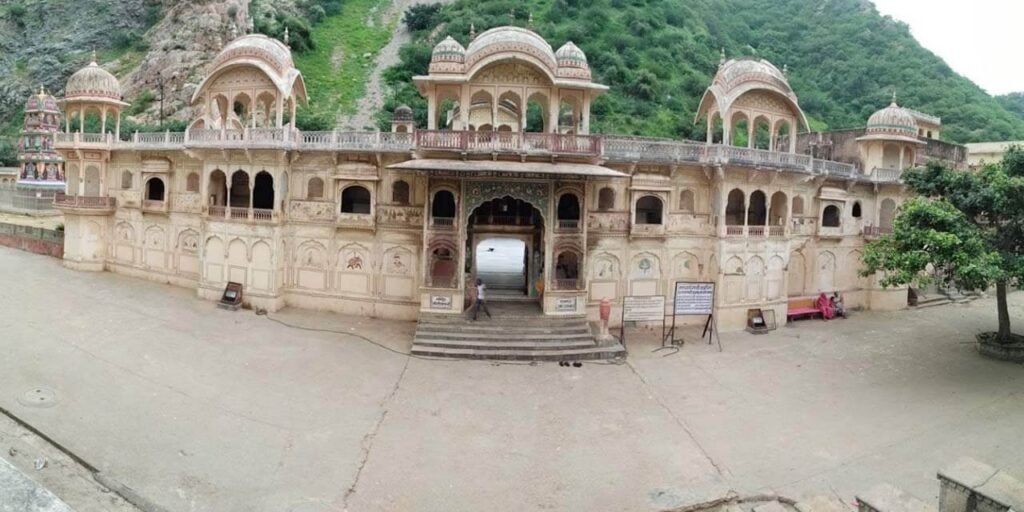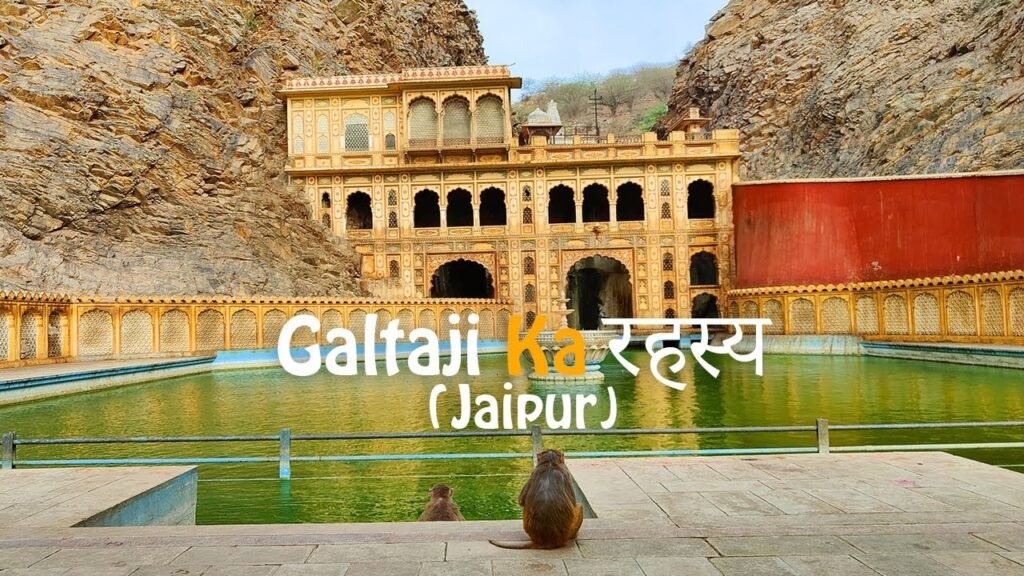Located amidst the rugged Aravalli hills, Galta Ji Temple is not just an architectural gem, but a vibrant living pilgrimage wrapped in centuries of tradition and myth. From its ancient springs to its famed winged inhabitants, the monkeys, this site is integral to Rajasthan’s religious and cultural landscape.
Location & Map
Where: Khaina-Balaji, 10km east of Jaipur, Rajasthan, India.
Coordinates: 26.8761°N 76.1242°E.
Route & How To Reach Galta Ji Temple
Just 10 km east of Jaipur city, Galta Ji Temple is accessible by multiple means:
- By Road: Auto-rickshaws, e-rickshaws, taxis, and private cars are readily available. Apps like Ola and Uber offer efficient service.
- By Bus: State and deluxe buses reach nearby stops such as Vidyadharji Ka Bagh, from where autos can take visitors the final stretch.
- By Train: Bais Godam Railway Station is the nearest, 1 km away.
- By Air: Jaipur International Airport is about 17 km from the temple.
The approach features scenic hill trails for those seeking a bit of adventure and panoramic city views.
Key Details:
Historical and Cultural Significance
The origins of the Galta Ji Temple reach deep into Hindu mythology and regional lore. Its namesake, Saint Galav, is believed to have meditated here for a hundred years, earning divine blessings that have kept the temple’s sacred springs flowing ever since. The site gained prominence during the early 18th century under Sawai Jai Singh II, the founder of Jaipur, with the striking temple complex constructed by his courtier, Diwan Rao Kriparam.
Culturally, the Galta Ji Temple flourished as a hub for ascetics, especially for the Ramanandi sect of Vaishnavism. The temple houses shrines to Hanuman, Lord Rama, Krishna, the Sun God, and more, making it an enduring centre of devotion, meditation, and spiritual discipline. The celebration of Makar Sankranti and Holi in Jaipur attracts huge crowds, symbolising the city’s inclusive festive spirit.
Architectural Marvels and Temple Layout
Galta Ji Temple stands apart as more than a singular temple; it’s a sprawling complex of shrines, pavilions, frescoed halls, and stepwells, all crafted from pink sandstone. The temples are adorned with Rajasthani and Mughal flourishes, including intricate domes and latticed columns. Scenic terraces and courtyards unfold along the hilly gorge, leading to a series of seven holy Kunds (water tanks), continuously replenished by the “Gaumukh”, a rock carved in the shape of a cow’s mouth.
Among the shrines are:
- Hanuman Temple, noted for its resident monkey tribes.
- Ram Gopal Temple, renowned for its idol that combines features of Lord Krishna and Ram.
- Sun God Temple (Surya Mandir), perched atop the complex, offers unparalleled views of Jaipur.
The Monkeys and Spiritual Ambience
Galta Ji Temple is affectionately dubbed Jaipur’s “Monkey Temple.” Hundreds of monkeys, predominantly Rhesus macaques, roam the grounds, captivating and sometimes startling visitors. These playful primates are an inseparable part of Galta Ji’s charm and have inspired folklore around the temple’s origins and guardianship.
Pilgrims and tourists alike undertake ritual bathing in the sacred Kunds, believing that the pure, spring-fed waters wash away their sins and bring spiritual merit.
Tourist Experience: Best Time to Visit & Rituals
The Galta Ji Temple complex is accessible year-round, but the festivals of Makar Sankranti (January) and Holi (March) attract a surge in pilgrimages, marked by vibrant rituals and flower-strewn celebrations. The temple’s serenity, gently interrupted by the sounds of chants and wildlife, makes it a unique spot for spiritual seekers and photographers alike.
Hours: Open from sunrise to sunset, with no entry ticket (a small photography fee may apply).

Revenue, Local Economy & Recent Developments
As a top religious and tourist attraction, Galta Ji Temple draws thousands of visitors daily, supporting a robust microeconomy of guides, vendors, and nearby hospitality businesses. With entry free but a fee for cameras, much of the temple’s direct revenue comes from donations, festival offerings, and ancillary tourism (including transport, food stalls, etc.).
In recent years, government-led conservation and beautification efforts have been underway, with a significant ₹11.94 crore redevelopment injecting new life and amenities into the historic site. Ongoing restoration ensures a balance between tradition and tourism, enhancing accessibility while protecting heritage.
Recent Headlines & News
Government Takeover Revamps Galta Ji Temple
In 2024, the Rajasthan High Court directed state authorities to assume administration, ensuring transparent management and improved festival organisation. The annual Phagotsav/Holi festival now features expanded programming, enhanced safety, and major upgrades in crowd management, further securing Galta Ji’s place as a spiritual landmark.
Administrative changes also addressed community concerns, including stewardship succession and ritual continuity, reflecting an ongoing evolution in how heritage sites adapt to modern governance needs.
FAQs About Galta Ji Temple
Why is Galta Ji called the Monkey Temple?
Galta Ji Temple earned this nickname due to its large, settled population of monkeys, primarily Rhesus macaques, who roam its premises and mingle with devotees. These monkeys are believed to embody the spirit of Hanuman, the monkey god.
What makes the Kunds (water tanks) special?
The temple’s Kunds, especially Galta Kund, are considered miraculous for never running dry, even during droughts, attributed to the blessings received by Saint Galav. Pilgrims bathe here seeking purification and divine grace.
Can tourists visit the temple, and is it safe?
Yes, the Galta Ji Temple welcomes both pilgrims and tourists. The temple is generally safe, though visitors are advised to be cautious with personal belongings and avoid provoking the monkeys. Modest attire and respect for local customs are important.
Are there any entry fees?
Entry to the temple is free; however, a small fee may be required for photography. Donations are customary but not mandatory.
What are the main festivals celebrated at Galta Ji?
Makar Sankranti and Holi (Phagotsav) are the biggest festivals, drawing thousands of devotees for ritual bathing, flower celebrations, and devotional music.
How do recent renovations impact the visitor experience?
The 2024-2025 restoration and government stewardship have led to improved infrastructure, better management during festivals, and increased comfort for visitors without compromising the temple’s ancient ambience.
What is the mythological connection of Galta Ji?
Legend says Saint Galav meditated here, earning the unceasing natural spring from the gods. The site is also linked to Tulsidas, the author of the Ramcharitmanas, who is believed to have composed parts of the epic here.
